Remember when the central banks were tapering their asset purchases in the belief that the economy was strong enough that interest rates could “normalize”? There’s a reason why this narrative has disappeared down the memory hole. It’s not just because of Covid.
As Economist Daniel Lacalle points out in this article, economies that are addicted to rising debt eventually find themselves unable to tolerate what historically seem like tiny increases in the rate of interest.
“What happens when the central bank makes the highest-quality and lowest-risk asset extremely expensive? That savers take more and more risk for lower yields in other assets and that the perception of risk is clouded, driving investors to take too much risk in equities and bonds because the central bank is manipulating the most important risk signal: rates.”
“A mild increase of US 10-year bond yields to 2%, a more than logical move considering inflation expectations and the recovery of the economy, may cause a financial crisis not because of this modest rise, but because of the massive level of risk built in the economy from the prior artificial depression of those yields.”
I have to disagree with Lacalle on one point: I think the economy will be hit by a wave of debt default long before we see rapidly accelerating prices for consumer goods. The main concern of many folks will not be the price of a steak, but their ability to make the next mortgage payment on a million dollar home.


